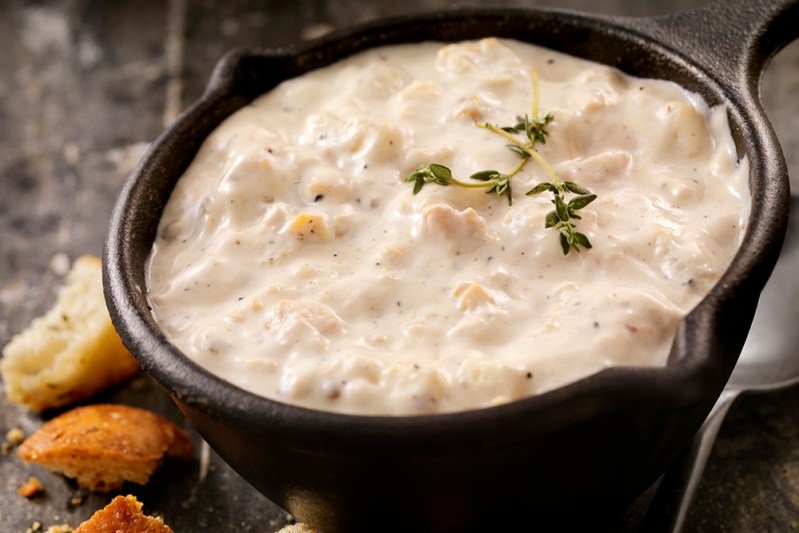Clam chowder is royalty in the bowl, easily one of the best soups out there. There are a few worthwhile canned versions around but the best stuff tends to be from your favorite seafood eatery or the batch you whip up at home.
On planet soup, clam chowder is an especially compelling type because it doesn’t have to stay on the rails. Like chili or barbecue sauce, a good version can veer in any number of directions, whether it’s changing up the base or adding a less expected vegetable or type of shellfish. Plus, it’s a fun thing to dip into, whether it’s ladled into a bread bowl or topped with crumbled salt crackers.

Clam Chowder
If you’re looking for simple yet satisfying, Jamie Oliver usually has you covered. His Mussel Chowder recipe takes only a half hour to prepare and is a comforting batch built around shellfish and corn. We recommend it on its own or with a hearty slab of rustic bread or some fried clams. You can even experiment a bit, swapping mussels out for things like seared scallops, crab, or, of course, your choice of clams.
Ingredients:
- 6-8 slices of bacon, chopped
- 1 small white onion, finely chopped
- 2 sticks celery, finely chopped
- 1 fresh red chili, deseeded and finely chopped
- 4 ears sweetcorn
- 2 medium potatoes, peeled and chopped
- 3.75 cups organic vegetable or fish stock, hot
- 1 handful fresh live mussels from sustainable sources (ask your fishmonger), cleaned and drained
- 4 tablespoons single cream
- 1 small handful chopped fresh parsley
Method:
- Heat a splash of oil in a large saucepan over a medium-low heat. Add the bacon, onion, celery and chili and sweat down for 5 minutes, stirring, until soft but not browned.
- Peel the husk from the corn and slice off the kernels with a sharp knife. Add the sweetcorn and potato to the saucepan, along with the stock. Bring to a boil, then simmer gently for 10 minutes, or until the potato is soft. Blitz very roughly with a hand blender (or cool slightly, then blend in batches in a food processor, returning the chowder to the saucepan).
- Add the mussels and cream, bring quickly to a boil and cook for a few minutes until the mussels have opened — discard any that remain closed. You can take the mussels out of their shells, if you like. Remove from the heat and season. Divide the chowder between bowls and serve sprinkled with the chopped parsley.
Genesis Story
Clam chowder was born on the East Coast in the colonial era, likely introduced by European immigrants. The milky New England style predates the tomato-centric Manhattan style and has since become the most popular version. In the early days, it was a go-to among Catholics who abstained from meat on Fridays. It’s documented to have shown up at restaurants by the 1830s, first at Boston’s famous Union Oyster House.
There are a host of other versions split up by regional preferences. Delaware Clam Chowder is less thick and based on a clearer salted broth. Long Island style is essentially a 50-50 blend of New England and Manhattan riffs. There’s also a Maine version focused on steamer clams and Rhode Island clam chowder, which is built around tomatoes but lacks the chunks that the Manhattan riff has.
What unifies nearly all clam chowder recipes? Just about all of the recipes out there rely on clams, potatoes, onions, and pork.
How to Make It
For starters, do not fear salty pork. It tends to work better than bacon as it rarely is flavored or heavily smoked. Cook it on low heat, patiently, with other items like onions and celery. The juices you extract here (from the meat especially) will form the backbone of the base.
Some add cornstarch but too much can mess up the creamy consistency you’re after with a good New England clam chowder. Most chowder-heads add little in the way of spices outside of some black pepper and bay leaves. What of the clams? Quahogs are ideal for the task and the most popular but cherrystones and top necks are about as good, although usually not as big. The important part here is not turning them to rubber by overcooking. Steam them in the same pot in some water and pull out the meat when the shells open. Set the clam meat aside until late.
You can use a combination of flour and butter and the juices rendered from the pork (and even a bit of clam juice) to thicken things. This is a good time to cook your spuds in milk and allow the starch at play to bind things. But it almost certainly won’t create the texture you’re after unless you toss the liquid in the blender with some cream. At this point, you should have a fairly creamy base to throw your clams and diced veggies in (and pork bits if you want more pork-ness). Don’t be upset if you don’t get the texture you’re after the first time. Play around a bit, trying a few recipes from your favorite culinary sites.
Folks tend to top chowder with crackers but we also like green onions, fried onions, bacon, croutons, or anchovies. If you’re after a good pairing, try a creamy white wine like a Pinot Blanc, a clean and lightly-oaked Chardonnay, or, if you’re feeling like a cold one, an oyster stout.
Editors' Recommendations
- How to make the best vodka gimlet for a twist on a classic
- How to craft a heavenly vodka martini: Shaken or stirred
- The 11 best grill and smoker recipes to make now
- How to make the perfect carnitas, according to a chef
- The grasshopper drink is a retro blast from the past — this is how to make it


